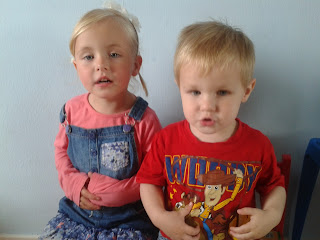 |
| Joseph Priestley |
Today is the First of August 2012. On this day 238 years ago in 1774 Joseph Priestley discovered oxygen .
 |
| Our Calendar |
James Priestley was a English Scientist.
 |
| This is England! |
He was a very curious man. He did lots of experiments. During his experiments he discovered Oxygen.
 |
| The symbol for Oxygen |
O is for Oxygen. Practise the Jolly Phonics. Pretend to turn a light switch on and off and say O, O, O,O
I got my children to place their hands on their tummies and take deep breathes so they could feel the movement of their diaphragms as they breathe.
It makes its way into our lungs. The oxygen then hitches a ride of our red blood cells and travels all around our body.
I squeezed the bottle onto their faces so they could feel the air blow out.
The air can also make things move. We can see the leaves rustling on the trees and our washing swaying on the line.
We blew through a straw to make balls of cotton move around the table.
Macey figured out she could also use the empty bottle to move the cotton balls.
We then made paper windmills and watched the air blow them round in the garden.
We also filled a carrier bag with air and squeezed it back out.
 |
| Jolly Phonic workbook page. |
What Is Oxygen?
We can't see oxygen. It is invisible. We can't see it and we can't smell it. Oxygen is very important. Without it nothing could exist. We would not be here. Oxygen is in the air all around us and in the water we drink. All plants and animals need to breathe. We breathe in air from our nose and our mouths.I got my children to place their hands on their tummies and take deep breathes so they could feel the movement of their diaphragms as they breathe.
 |
| We can feel our tummies move when we breathe in and out. |
It makes its way into our lungs. The oxygen then hitches a ride of our red blood cells and travels all around our body.
What Is Air?
Air is a mixture of Oxygen and other invisible gases. It is all around us but we can't see it. So if we can't see it how do we know it is there?
I used a empty pop bottle to demonstrate the existence of air. What is in the bottle?
I used a empty pop bottle to demonstrate the existence of air. What is in the bottle?
 |
| Nothing? Right? |
I squeezed the bottle onto their faces so they could feel the air blow out.
 |
| Macey squeezing the bottle so Drew can feel the air. |
The air can also make things move. We can see the leaves rustling on the trees and our washing swaying on the line.
We blew through a straw to make balls of cotton move around the table.
Macey figured out she could also use the empty bottle to move the cotton balls.
 |
| Wow! Look what I can do :) |
We then made paper windmills and watched the air blow them round in the garden.
We also filled a carrier bag with air and squeezed it back out.
 |
| Filling the bag with air. |
 |
| Catching it |
 |
| Squeezing it out :) |
Where Does Oxygen Come From?
Oxygen comes from plants. Like us plants need food to give them energy. The plants use sunlight, water. and air to make a sugar. They use this sugar to give them energy to help them grow. This is called photosynthesis. Once they have finished making their food there is some oxygen left over. They release this oxygen so we can breathe it in. Joseph Priestley was the first person to discover this.
Oxygen experiment .
We cut a healthy leaf from a plant and placed it in a glass of water and placed it in a sunny spot.
After a hour we could see lots of little oxygen bubbles all over the leaf and the glass
How To Grow A Planet
This 3 episode tv series is a good documentary to watch to back up today's lesson. Professor Iain Stewart reveals how the greatest changes to Earth have been driven by plants.
We watched the first episode Life From Light which shows how plants first harnessed light from the sun and created our life giving atmosphere.
Fire needs Oxygen too.
We lit two candles. We put the pink one to one side and placed a glass over the yellow one. The children saw how the pink candle had plenty of air and stayed alight whereas the yellow one quickly reduced in size and went out.










No comments:
Post a Comment